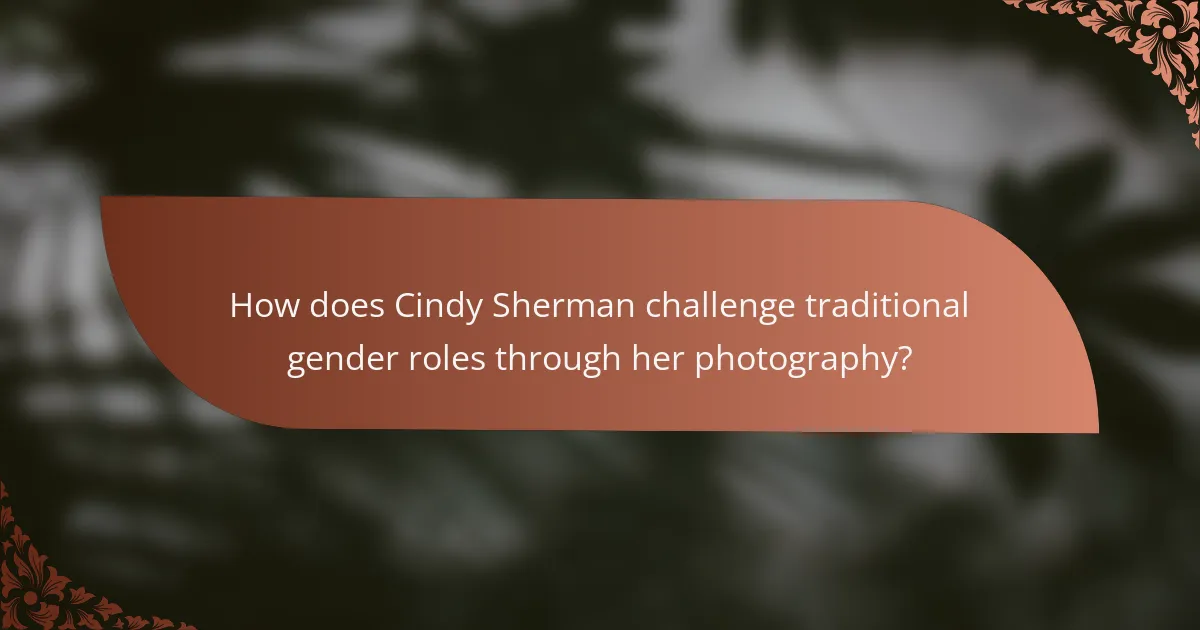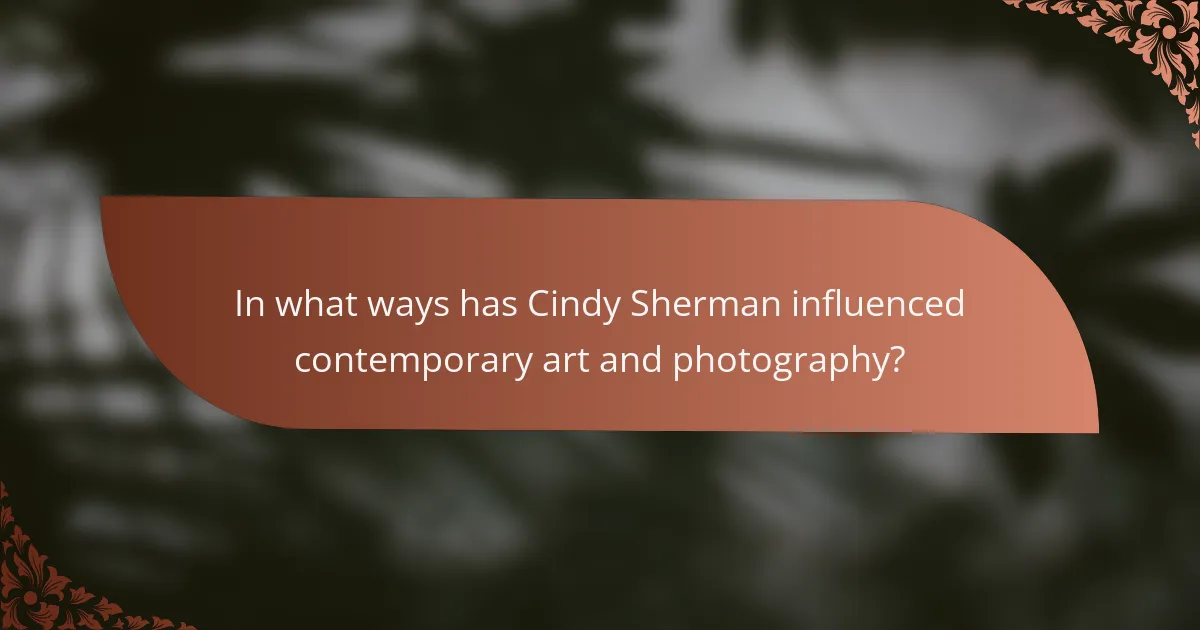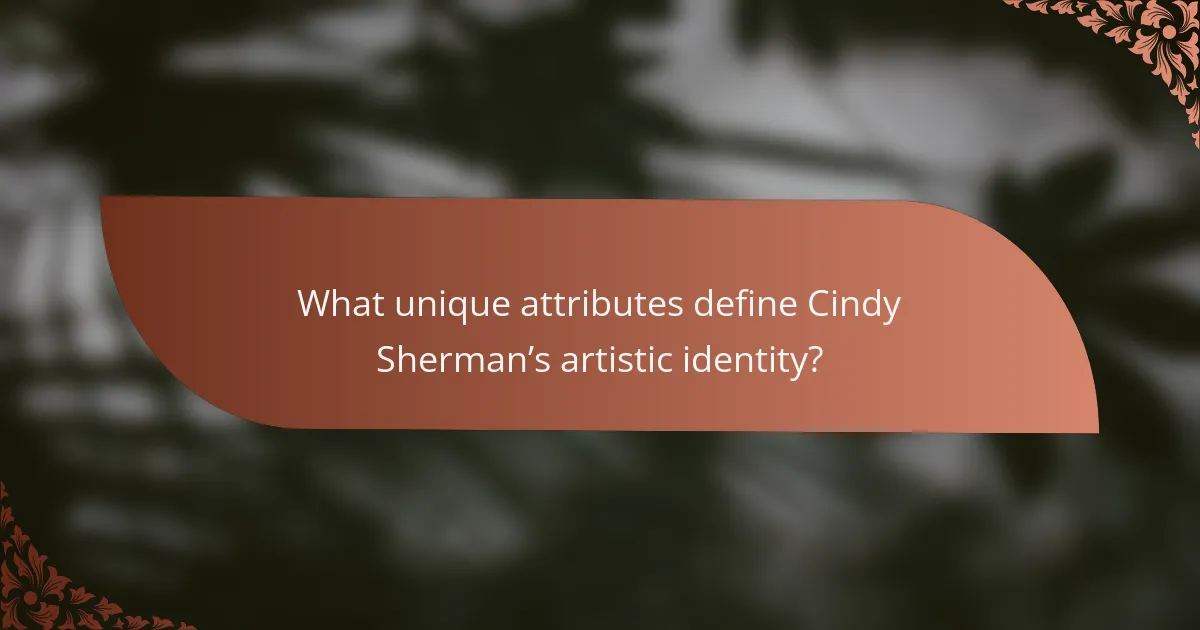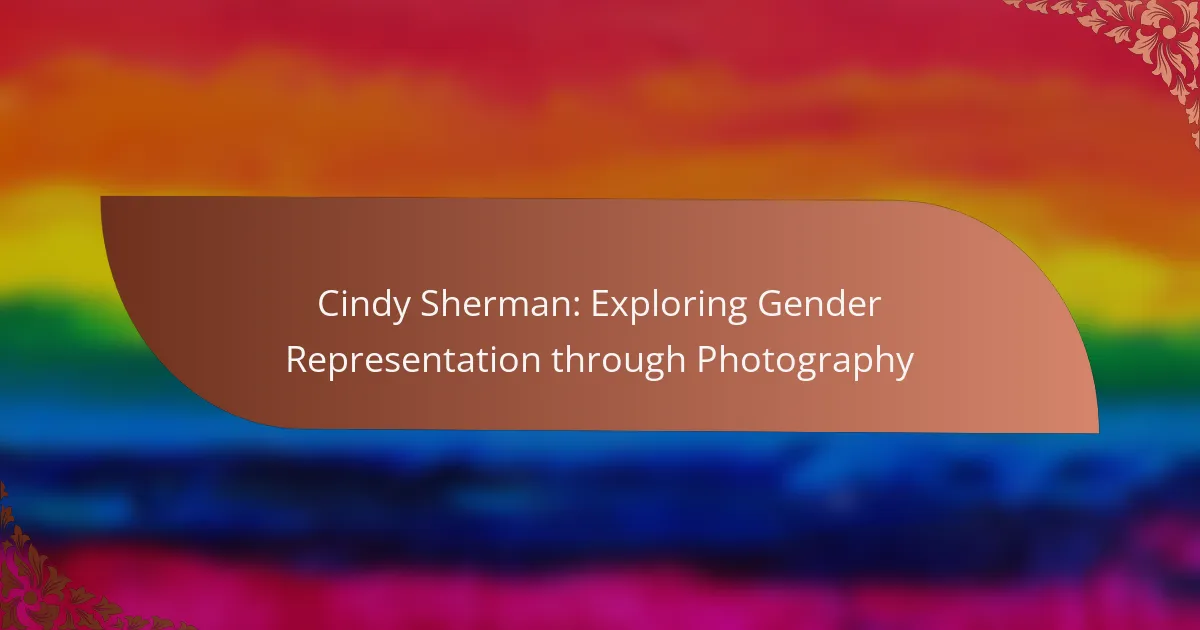Cindy Sherman’s photography challenges traditional gender roles and stereotypes, prompting critical discussions on identity and representation. Her self-portraits explore the performative nature of femininity through role-playing and costume design. Iconic series like “Untitled Film Stills” deconstruct societal norms, while her innovative techniques blur the lines between art and commercial imagery. Sherman’s work invites viewers to question the authenticity of gendered imagery and the narratives surrounding femininity and masculinity.

How does Cindy Sherman challenge traditional gender roles through her photography?
Cindy Sherman challenges traditional gender roles by subverting stereotypes through her multifaceted self-portraits. Her work often portrays women in exaggerated roles, prompting viewers to question societal expectations. By utilizing costumes, makeup, and props, Sherman transforms herself into various characters, illustrating the performative nature of gender. This approach highlights the constructed aspects of femininity and invites critical discussions about identity and representation. Sherman’s unique ability to shift between roles emphasizes the fluidity of gender, making her photography a powerful commentary on the limitations imposed by traditional gender norms.
What themes are prevalent in Sherman’s work regarding femininity?
Cindy Sherman frequently explores themes of identity, self-representation, and societal perceptions of femininity. Her work critiques traditional gender roles by employing various personas and archetypes. For example, she challenges stereotypes through her staged photographs, which often highlight the constructed nature of femininity. Additionally, Sherman’s use of makeup and costume underscores the performative aspects of gender. The juxtaposition of beauty and grotesqueness in her images reveals the complexities of female identity. Overall, her art invites viewers to question the authenticity of gender representations in media and culture.
How do Sherman’s self-portraits reflect societal expectations of women?
Cindy Sherman’s self-portraits challenge societal expectations of women by subverting traditional roles. Through her work, Sherman embodies various female archetypes, revealing the constructed nature of gender identity. Her photographs critique the media’s portrayal of women, highlighting issues of objectification and stereotype. By presenting herself in diverse contexts, she encourages viewers to question societal norms surrounding femininity and identity.
Which cultural contexts influence Sherman’s portrayal of gender?
Cindy Sherman’s portrayal of gender is influenced by various cultural contexts, including feminism, popular media, and art history. Feminist movements challenge traditional gender roles, prompting Sherman to explore identity and representation. Popular media shapes societal perceptions of gender, which Sherman critiques through her work. Additionally, art history provides a backdrop for her exploration of female archetypes, allowing her to recontextualize and subvert established norms. These contexts create a multifaceted dialogue around gender in her photography.
![]()
What techniques does Cindy Sherman use to create her iconic images?
Cindy Sherman employs techniques such as role-playing, costume design, and makeup to create her iconic images. She uses self-portraiture to explore and challenge gender stereotypes, often transforming herself into various characters. Through these transformations, she critiques societal norms around femininity. Sherman’s use of theatricality and narrative elements enhances the visual storytelling in her work.
How does the use of costume and makeup shape her narratives?
Cindy Sherman uses costume and makeup to create multifaceted narratives that challenge gender representation. Her work highlights the fluidity of identity and societal roles through visual storytelling. By transforming herself into various characters, Sherman critiques stereotypes and explores the complexity of femininity. Each persona she embodies serves as a commentary on cultural expectations, allowing viewers to reflect on their perceptions of gender. Her innovative approach emphasizes that identity is not fixed but rather constructed through performance and visual representation.
What role does staging play in her photographic storytelling?
Staging plays a critical role in Cindy Sherman’s photographic storytelling by creating contexts that challenge gender norms. Through meticulously crafted scenes, she constructs narratives that explore identity, societal roles, and the performative aspects of femininity. Each staged photograph serves as a commentary on the expectations placed on women, utilizing props, costumes, and settings to evoke specific cultural references. This approach allows Sherman to manipulate viewer perceptions and provoke thoughtful discussions about representation and authenticity in art.
Which visual styles are prominent in Sherman’s portfolio?
Cindy Sherman’s portfolio prominently features visual styles such as staged self-portraiture, cinematic imagery, and conceptual art. Her work often explores themes of identity, gender roles, and societal expectations. The unique attribute of her photography is the transformation into various characters, each representing different facets of femininity. Additionally, her use of bold colors and elaborate costumes enhances the narrative quality of her images.

In what ways has Cindy Sherman influenced contemporary art and photography?
Cindy Sherman has profoundly influenced contemporary art and photography by challenging traditional gender roles. Her work, primarily through self-portraiture, explores identity, representation, and the complexities of femininity.
Sherman’s iconic series, such as “Untitled Film Stills,” deconstructs stereotypes by presenting herself in various roles, revealing the performative nature of identity. This approach has inspired artists to examine societal norms and the portrayal of women in media.
Additionally, her use of makeup, costumes, and props showcases the transformative power of photography. This method encourages viewers to question the authenticity of images and the constructed nature of identity.
Overall, Sherman’s impact lies in her ability to provoke critical discussions on gender and representation, making her a pivotal figure in contemporary art and photography.
How do her works resonate with current feminist movements?
Cindy Sherman’s works resonate deeply with current feminist movements by challenging traditional gender roles. Her photography deconstructs stereotypes, reflecting the complexities of female identity in contemporary society. This aligns with feminist goals of promoting diverse representations and questioning societal norms. Sherman’s unique approach highlights the performative aspects of gender, encouraging dialogue about authenticity and self-representation. As a result, her art remains relevant, inspiring new generations to explore and redefine femininity.
Which artists cite Sherman as an inspiration for their own gender explorations?
Artists such as Yasumasa Morimura, Cindy Sherman herself, and Nikki S. Lee cite Cindy Sherman as an inspiration for their explorations of gender representation. These artists utilize photography to challenge and redefine gender norms. For example, Morimura often reinterprets iconic images, using his own body to explore identity and gender fluidity. Sherman’s work, characterized by self-portraiture, has influenced many in their approach to visual storytelling and gender expression. Lee’s projects involve role-playing and cultural commentary, reflecting Sherman’s impact on contemporary art.

What unique attributes define Cindy Sherman’s artistic identity?
Cindy Sherman’s artistic identity is defined by her unique exploration of identity, gender, and societal roles through self-portraiture. She employs elaborate costumes and makeup to transform into various characters, challenging traditional notions of femininity. Her work often critiques the representation of women in media, creating a dialogue about identity and perception. Additionally, Sherman’s innovative use of photography blurs the lines between art and commercial imagery, establishing her as a pivotal figure in contemporary art.
How does her approach to identity differ from other contemporary artists?
Cindy Sherman’s approach to identity is distinct due to her focus on performance and self-representation. Unlike many contemporary artists, she uses photography to explore the fluidity of gender roles. Sherman embodies various personas, challenging traditional notions of identity through visual storytelling. Her work often critiques societal expectations, making her perspective on identity uniquely provocative.
What personal experiences shape her artistic vision?
Cindy Sherman’s artistic vision is shaped by her personal experiences with identity and societal roles. Her childhood in New Jersey, combined with her exposure to the media, influenced her exploration of gender representation. Sherman often draws from her own life, using photography to challenge and critique stereotypes. This unique perspective allows her to create powerful narratives that reflect her understanding of femininity and identity.

What are some rare attributes found in specific series of Cindy Sherman’s work?
Cindy Sherman’s work features rare attributes such as the use of historical references, unconventional materials, and hybrid identities. These elements challenge traditional gender norms and provoke deeper societal reflections. Sherman’s series often blend self-portraiture with cultural commentary, showcasing a unique interplay between identity and representation. The incorporation of cinematic techniques within her photography also highlights the performative aspects of gender.
Which less-known projects reveal deeper insights into her exploration of gender?
Cindy Sherman’s lesser-known projects, such as “Untitled Film Stills” and “History Portraits,” reveal profound insights into gender representation. These works challenge traditional narratives by subverting stereotypes and exploring identity through constructed personas. Sherman’s ability to manipulate visual language demonstrates the fluidity of gender roles. Her exploration of societal expectations and self-perception creates a complex dialogue about femininity and power dynamics.
How do her experimental works differ from her more recognized pieces?
Cindy Sherman’s experimental works often challenge traditional narratives, while her recognized pieces typically reinforce established themes. Experimental works focus on abstract concepts, exploring identity and gender fluidity, whereas recognized pieces emphasize specific roles and stereotypes. This distinction highlights her innovative approach to gender representation.

What practical insights can be gained from studying Cindy Sherman’s work?
Studying Cindy Sherman’s work reveals insights into the complexities of gender representation in contemporary society. Her photography challenges traditional roles and stereotypes, encouraging critical reflection on identity and self-perception.
Sherman’s use of disguise and persona allows viewers to question the authenticity of gendered imagery. This approach highlights the performative aspects of gender, illustrating that identity is not fixed but rather constructed through societal influences.
Moreover, her work prompts discussions about the male gaze and the objectification of women in media. By subverting expectations, Sherman empowers viewers to reconsider the narratives surrounding femininity and masculinity.
Overall, engaging with Sherman’s art fosters a deeper understanding of how visual culture shapes our perceptions of gender and identity.
What best practices can photographers adopt from her techniques?
Photographers can adopt several best practices from Cindy Sherman’s techniques to enhance their work. First, they should explore identity and representation, using self-portraiture to challenge societal norms. Second, photographers can experiment with narrative by creating characters that convey deeper messages. Third, incorporating costume and makeup can transform the visual storytelling, adding layers of meaning. Lastly, embracing ambiguity in images encourages viewers to engage critically with the work. These practices can foster innovative approaches to photography and deepen audience connection.
Which common mistakes should artists avoid when exploring gender representation?
Artists exploring gender representation should avoid stereotypes, oversimplification, and neglecting intersectionality. Failing to challenge societal norms can lead to superficial portrayals. Additionally, relying solely on personal experience may limit broader perspectives. Engaging with diverse voices enriches representation and deepens understanding.
